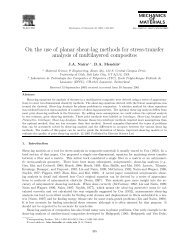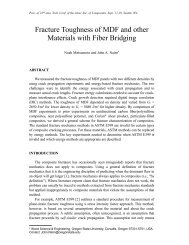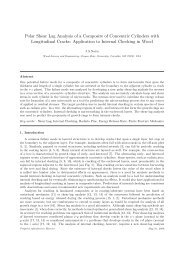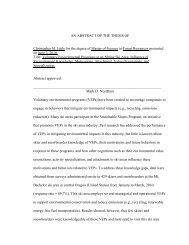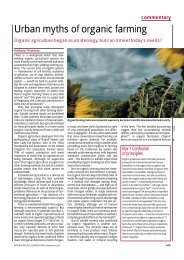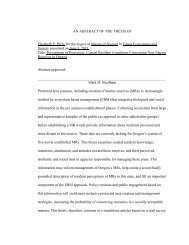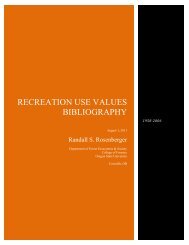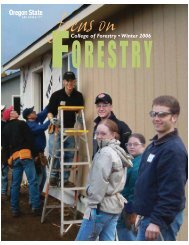College of Forestry - Oregon State University
College of Forestry - Oregon State University
College of Forestry - Oregon State University
You also want an ePaper? Increase the reach of your titles
YUMPU automatically turns print PDFs into web optimized ePapers that Google loves.
Features<br />
Meticulous Measurements Yield Meaningful Models<br />
Inchworm, inchworm, measuring the marigolds, you and your arithmetic will probably go far.—Frank Loesser,<br />
Hans Christian Andersen<br />
Douglas-firs are a lot bigger than marigolds,<br />
and the math involved is far more<br />
than arithmetic, but David Hann has indeed<br />
gone far with measuring and modeling<br />
forest stands. “My mandate when<br />
I arrived at <strong>Oregon</strong> <strong>State</strong> was to create growth-and-yield<br />
models,” says Hann, forest biometrician and Pr<strong>of</strong>essor <strong>of</strong><br />
Forest Resources. So, for some 29 years, he has.<br />
Biometricians create mathematical models to depict<br />
virtual forest stands and then test which models are best<br />
at predicting stand behavior under different conditions.<br />
Biometric models are built using statistics applied to data<br />
obtained from actual forest stands, and obtaining data<br />
sets adequate for the task has presented a continuing<br />
challenge. One <strong>of</strong> Hann’s major contributions has been<br />
developing rigorous sampling methodologies and data<br />
quality procedures that produce valid, broadly applicable<br />
models while reflecting actual operational practices.<br />
Such models require years <strong>of</strong> painstaking work to<br />
put together and validate. The model that is perhaps best<br />
known to <strong>Oregon</strong> forestland managers is ORGANON<br />
(ORegon Growth ANalysis and ProjectiON), an individual-tree<br />
growth model developed for Southwest <strong>Oregon</strong>,<br />
Northwest <strong>Oregon</strong>, and the lands <strong>of</strong> the Stand Management<br />
Cooperative in <strong>Oregon</strong> and Washington. Developing<br />
the first two versions <strong>of</strong> ORGANON required about<br />
a decade. Hann and his collaborators had to collect the<br />
data, develop the s<strong>of</strong>tware, the database, and the model,<br />
and make sure the individual equations worked well<br />
together (“not a trivial process”, as Hann observes). The<br />
model for Southwest <strong>Oregon</strong> is based on data Hann collected<br />
as part <strong>of</strong> the FIR (<strong>Forestry</strong> Intensive Research)<br />
and northern spotted owl habitat projects; the model<br />
for Northwest <strong>Oregon</strong> is based on data from the inventory<br />
he set up for the <strong>College</strong> Forests. Hann is constantly<br />
refining the model and revising it for application to<br />
different species mixes, stand structures, and management<br />
activities, including forest health and maintaining<br />
threatened species.<br />
11<br />
“Two things distinguish ORGANON from other<br />
regional growth and yield models,” Hann points out.<br />
“The quality <strong>of</strong> data is much higher than in any other<br />
models, and each variant has seen extensive and exhaustive<br />
verification through peer-reviewed publication—no<br />
other model can say that!”<br />
When Hann started out as an undergraduate student,<br />
his first decision was how much to spend for a slide<br />
rule. Over the decades, he has ridden the cusp <strong>of</strong> the<br />
computer revolution, from a small mainframe<br />
with a 32K central memory to personal<br />
computers with nearly unlimited capacity.<br />
Hann was among the first in<br />
the <strong>College</strong> to adopt personal<br />
computers for both research<br />
and teaching and was<br />
probably one <strong>of</strong> the<br />
first in the region to<br />
use them for statistical<br />
analysis.<br />
When Hann arrived<br />
at OSU, most forestland<br />
managers were using little<br />
books <strong>of</strong> normal yield tables. The<br />
one whole-stand model available<br />
required a mainframe computer. Now,<br />
managers use electronic growth-andyield<br />
models that can be run on<br />
laptop computers. Much has<br />
changed, but usable, precise<br />
growth-and-yield<br />
models that cover diverse<br />
situations remain<br />
invaluable to forestland<br />
managers.<br />
Mark L. Hanus ©1997 <strong>Oregon</strong> <strong>State</strong> <strong>University</strong>





